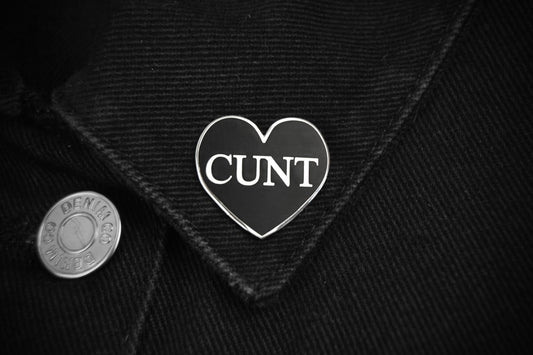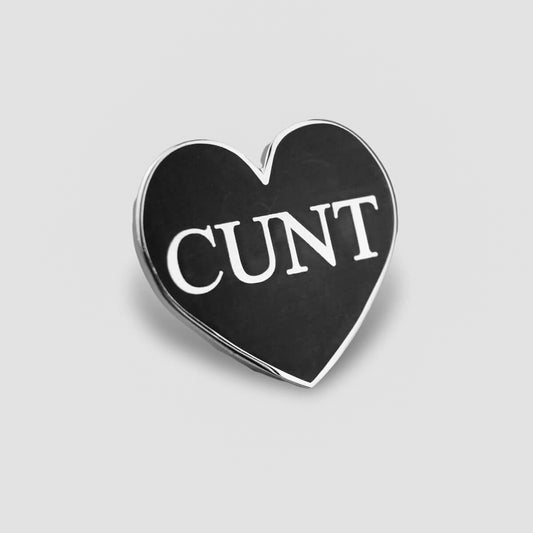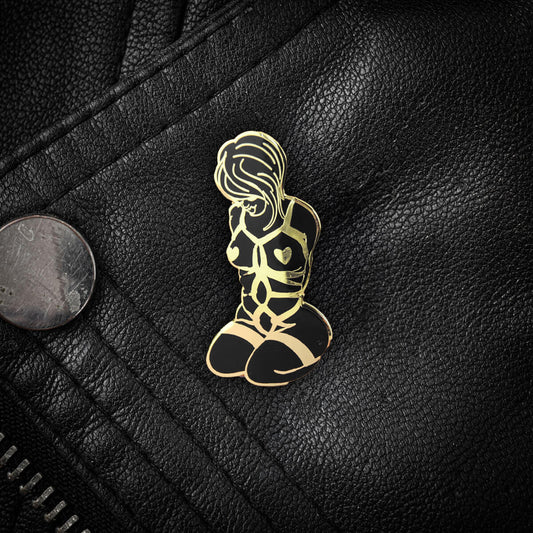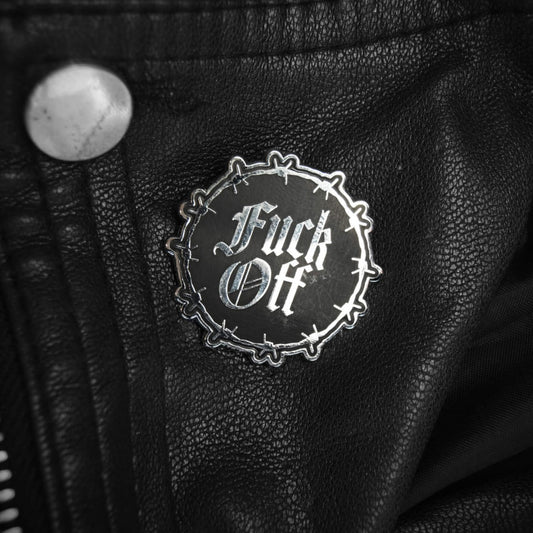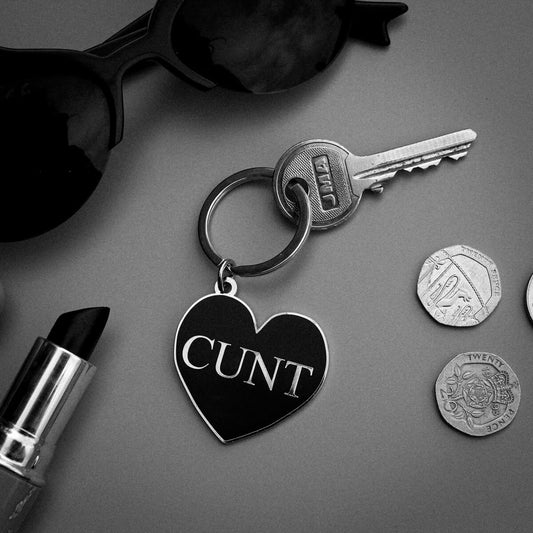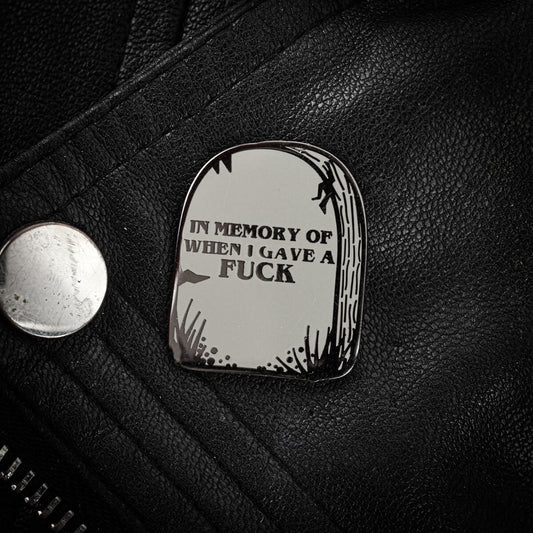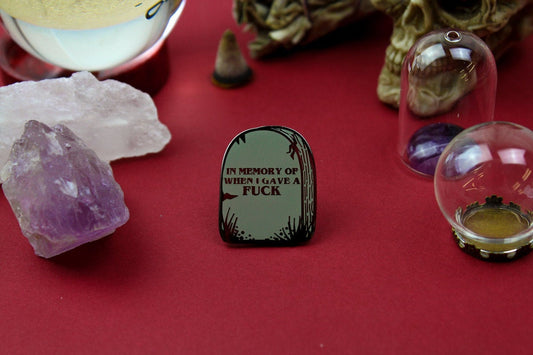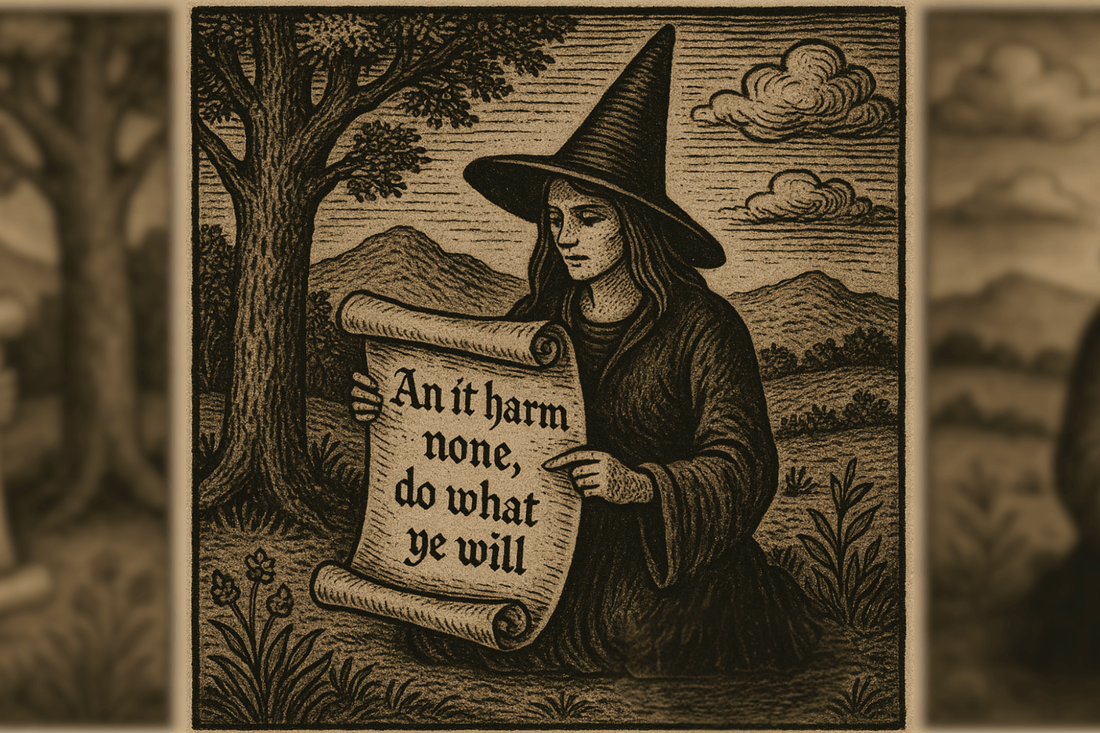
What is the Wiccan Rede?
Share
If you’re at all interested in Wicca, you’ve likely by now come across the Wiccan Rede, especially that one line: “An it harm none, do what ye will.” It’s printed on mugs, quoted in books, and even tossed into online arguments as if it settles everything. But what does it actually mean?
Some people think it’s a strict rule. Others treat it more like a flexible bit of advice. Then there’s the fact that a lot of people repeat it without even knowing it’s actually just one single line from a longer poem. And despite how old it sounds, the version most people know isn’t actually that old.
This article breaks down where the Rede came from, what it really says, and why it’s become such a big deal in modern Wicca.
Key Points:
- The Wiccan Rede is best known for the line “An it harm none, do what ye will”, but that’s just part of a longer poem published in the 1970s.
- It’s not a law or commandment. Wicca has no central authority, so how (or whether) someone follows the Rede varies widely.
- Living by “harm none” sounds simple, but real-life choices are rarely that clean. The phrase raises more questions than it answers.
- Some Wiccans see the Rede as a helpful ethical guide. Others view it as vague, idealistic, or watered down by pop culture.
- Despite debate, the Rede remains influential - mainly because it encourages thought, personal responsibility, and reflection.
The Famous Line
This is the bit nearly everyone knows. One short sentence that sounds simple, but isn’t. First off, the wording trips people up. “An” just means “if.” So the line really says, if it harms no one, do what you want.
But who decides what counts as harm? And is this about physical harm, emotional pain, damage to animals, ecosystems, or yourself? It’s vague, which is part of the problem and part of the appeal. Wiccans often interpret it as a reminder to think before acting. Intent matters, but so do consequences.
The line also gets compared to Aleister Crowley’s“Do what thou wilt shall be the whole of the Law.” Some think Wicca borrowed it. That’s not far off. Crowley wrote his version decades earlier, and both lines come from similar roots in Western occult philosophy. But the Wiccan take adds a condition: harm no one, which is a nice addition really!
Still, that “do what ye will” bit often gets misunderstood as a free pass to do anything. It isn’t. It sets a challenge: follow your will, but take full responsibility for what that means. If that sounds tricky, it’s because it is.
Photo by Dmitry Stepanov on Unsplash
The Full Rede Poem (The Long Rede)
A lot of people think the Wiccan Rede is just that one famous line. But there’s actually a much longer version, written in rhyming couplets and stretching to 26 lines. This version first appeared publicly in the 1970s, published by Lady Gwen Thompson in Green Egg, a pagan magazine. She claimed it came from her grandmother, but there’s no proof of that. Most scholars believe it was written around that time, not passed down through generations.
The poem goes way beyond “harm none.” It covers everything from moon phases and the Rule of Three, to casting circles and treating animals kindly. It reads more like a poetic summary of Wiccan ethics and ritual basics than a formal code of conduct.
There’s no official version either. Different sources show slight variations in wording and punctuation, which only adds to the confusion. Some Wiccans use the full poem as a kind of moral checklist. Others ignore it completely, saying it sounds too fluffy or too dated.
The longer Rede might look like scripture, but Wicca doesn’t do commandments. There’s no central authority handing out rules. So whether the poem means something to you, or nothing at all, depends entirely on your take. And that’s the point. Wicca encourages thinking, not just following.
Here is the full ‘Long Rede’, as published in Green Egg magazine in 1975, which is attributed to Lady Gwen Thompson:
- Bide the Wiccan laws ye must in perfect love an perfect trust.
- Live an let live - fairly take an fairly give.
- Cast the Circle thrice about to keep all evil spirits out.
- To bind the spell every time, let the spell be spake in rhyme.
- Soft of eye an light of touch - speak little, listen much.
- Deosil go by the waxing Moon - sing an dance the Wiccan rune.
- Widdershins go when the Moon doth wane, an the Werewolf howls by the dread Wolfsbane.
- When the Lady’s Moon is new, kiss the hand to her times two.
- When the Moon rides at her peak, then your heart’s desire seek.
- Heed the Northwind’s mighty gale - lock the door and drop the sail.
- When the wind comes from the South, love will kiss thee on the mouth.
- When the wind blows from the East, expect the new and set the feast.
- When the West wind blows o’er thee, departed spirits restless be.
- Nine woods in the Cauldron go - burn them quick an burn them slow.
- Elder be ye Lady’s tree - burn it not or cursed ye’ll be.
- When the Wheel begins to turn - let the Beltane fires burn.
- When the Wheel has turned a Yule, light the Log an let Pan rule.
- Heed ye flower, bush an tree – by the Lady blessed be.
- Where the rippling waters go, cast a stone an truth ye’ll know.
- When ye have need, hearken not to other’s greed.
- With the fool no season spend or be counted as his friend.
- Merry meet an merry part - bright the cheeks an warm the heart.
- Mind the Threefold Law ye should - three times bad an three times good.
- When misfortune is enow, wear the blue star on thy brow.
- True in love ever be unless thy lover’s false to thee.
- Eight words the Wiccan Rede fulfill - an it harm none, do what ye will.
Is the Rede a Law or Just Advice?
Wicca doesn’t have popes, prophets or sacred law books and there’s no council deciding what’s official and what’s not. That means the Wiccan Rede isn’t a rule in any formal sense. It’s more like a moral suggestion that just caught on.
Some Wiccans treat it like a serious ethical principle they try to live by. Others see it as poetic fluff with no real bite. The line “An it harm none, do what ye will” sounds neat, but it raises more questions than it answers. Does standing up for yourself count as harm? What about lying to protect someone’s feelings? There’s no easy formula.
Different Wiccan traditions approach it in different ways. Gardnerians and Alexandrians might mention it, but they don’t usually treat it as sacred doctrine. Eclectic Wiccans, especially those practising alone, are more likely to adopt it as a guiding rule. Online, it’s everywhere - quoted like gospel - but real-life practice tends to be more nuanced.
If you’re looking for a black-and-white rulebook, you won’t find one here. Wicca puts the responsibility back on the individual. That means the Rede isn’t a commandment - it’s a mirror. How you interpret it says more about your values than it does about Wicca as a whole.
“Harm None” – Easier Said Than Done
It sounds noble: harm no one, do what you want. But try applying that to real life and it falls apart fast.
Let’s say you end a toxic friendship. That person might feel hurt. Is that harm? You eat meat. Is that harm? You call out someone’s bad behaviour. Still harm? The problem isn’t that the Rede is unrealistic - it’s that harm is rarely black and white.
Plenty of Wiccans treat the Rede as a rule of thumb, not a hard limit. The aim isn’t to never cause any discomfort to anyone ever again. It’s to think before acting, to weigh your choices, and to try to do less damage where you can. Intention matters. So does impact. It’s about being responsible with your will, not acting on every whim and shrugging off the fallout.
Some go further. They say the Rede’s real message is to understand the web of cause and effect. Every action has ripples. “Harm none” isn’t about being nice all the time - it’s about being aware.
Of course, there are those who say the Rede sets people up to fail. Life involves conflict. You can’t please everyone. But even critics admit it encourages self-reflection, and that’s something most spiritual paths could do with more of.
Photo by Andres F. Uran on Unsplash
Critics and Contradictions
Even within Wicca, the Rede isn’t universally agreed on. Some treat it as a core principle. Others barely mention it. That divide isn’t just personal preference - it reflects deeper disagreements about what Wicca is supposed to be.
Traditional Wiccans, especially those in established initiatory covens, often see the Rede as just one part of a broader ethical framework. It’s not the foundation, it’s a footnote. For them, ritual structure, lineage, and the coven’s own teachings carry more weight. Meanwhile, eclectic Wiccans and solitary practitioners are more likely to treat the Rede as central, sometimes even sacred.
This split has sparked tension. Some argue that the Rede, in its popular form, has been overemphasised by books and online content aimed at beginners. This has resulted in a wave of newcomers thinking Wicca is all about light, love, and doing no harm - while missing the complexity, the history, and the grit.
There’s also the issue of moral tone. Critics say the Rede, especially when taken too literally, turns Wicca into a kind of pastel-flavoured spirituality. One that’s toothless, stripped of its magical edge, and obsessed with behaving nicely. That doesn’t sit well with witches who see the craft as a source of power, transformation, or even justified vengeance.
So the debate continues. Is the Rede a helpful ethical tool, or a watered-down catchphrase? Is it a genuine Wiccan teaching, or just a feel-good import from New Age culture? Like most things in Wicca, the answer depends on who you ask and how long they’ve been practising.
Influence Outside Wicca
The Wiccan Rede has wandered far beyond Wiccan circles. You’ll spot it in witchy TikToks, printed on tote bags, quoted in wellness blogs, and even dropped into pop culture scripts. Somewhere along the way, it stopped being a Wiccan ethic and became a general slogan for “do no harm” spirituality.
In some cases, people borrow the line without knowing where it came from. Others bend it to suit their own outlook, stripping it of context and turning it into feel-good advice. That’s not always a bad thing - it’s just what happens when an idea goes mainstream.
The problem is, once something gets flattened for mass use, the original meaning gets lost. Wiccans don’t all agree on the Rede’s role, but they usually treat it as something more thoughtful than just “be nice.” Outside of Wicca, that depth often gets ignored.
You’ll also see the Rede mashed together with other concepts like karma, the Threefold Law, or generalised pagan ethics. Some modern witches, especially those who aren’t Wiccan, push back against it completely. They say it’s limiting, unrealistic, or just not part of their belief system.
Still, the line has stuck around. Probably because it sounds empowering and peaceful at the same time. But if you’re going to quote it, it’s worth knowing where it came from - and what it originally meant to the people who first used it.
What It Means for Modern Wiccans
Ask ten modern Wiccans how they use the Rede and you’ll get a mix of answers. Some keep it pinned to their altar, quoting it as a daily reminder. Others barely mention it, preferring personal intuition or their tradition’s teachings. There’s no single approach - and no expectation that there should be.
Solitary practitioners often lean on the Rede as a simple moral compass. It’s flexible, easy to remember, and offers a clear line to come back to when things get murky. In contrast, those in structured covens might see it as more of a background principle than a guiding rule. For them, ethics are shaped by group customs, initiatory teachings, or even oath-bound material.
The Rede also ties into other ideas, like the Threefold Law - the belief that what you do comes back to you threefold. Some Wiccans take that literally. Others see it as symbolic. Either way, it reinforces the message: act with care, because actions ripple.
In the social media age, the Rede has taken on a new role. It’s become a kind of public-facing slogan for Wicca. Easy to share. Easy to misunderstand. That’s created pressure for some practitioners to live up to a soft-focus, harm-free image that doesn’t reflect the full reality of their practice.
Still, despite the debates, the Rede persists. Not because it’s perfect, but because it opens space for reflection. In a belief system built around personal responsibility, that might be the whole point.
Why the Rede Still Matters
For all its flaws, the Wiccan Rede hasn’t faded into irrelevance. It’s not a commandment. It’s not enforced. And it doesn’t answer every moral question. But it still holds weight - for a lot of people, in a lot of different ways.
It gives solitary Wiccans a simple ethical anchor. It offers beginners a starting point for thinking about responsibility and consequence. It reminds practitioners, no matter their path, to pause before acting. And even when it’s criticised or ignored, it’s still part of the conversation.
The Rede’s staying power comes from its openness. You can interpret it strictly or loosely. You can follow it to the letter or challenge it entirely. Either way, it pushes Wiccans to think for themselves.
That’s probably why it still matters. Not because it lays down the law - but because it doesn’t.
